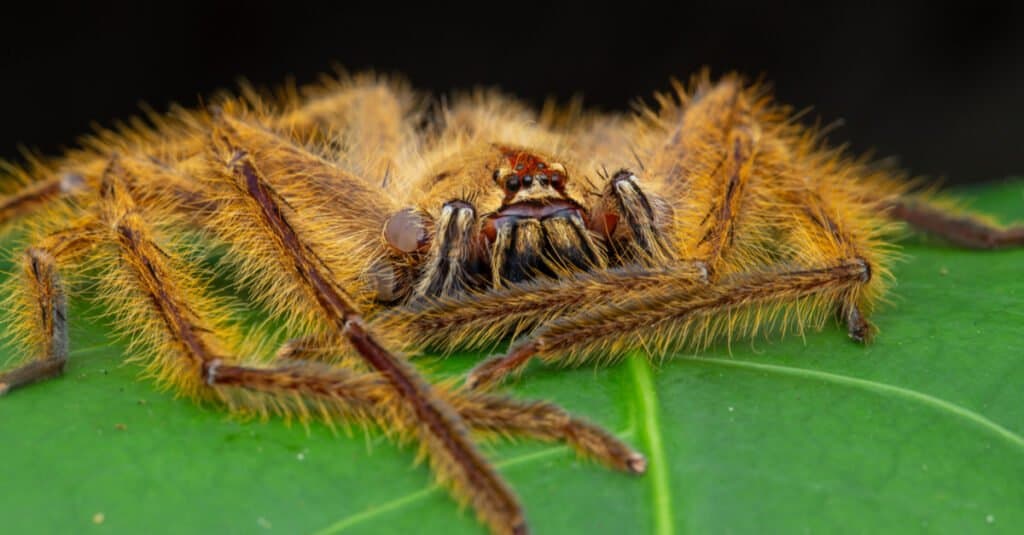Clock Spider
Heteropoda venatoria
Males make a rhythmic thrumming like a clock
Advertisement
Clock Spider Scientific Classification
- Kingdom
- Animalia
- Phylum
- Arthropoda
- Class
- Arachnida
- Order
- Araneae
- Family
- Sparassidae
- Genus
- Heteropoda
- Scientific Name
- Heteropoda venatoria
Read our Complete Guide to Classification of Animals.
Clock Spider Conservation Status
Clock Spider Facts
- Prey
- Insects, invertebrates, frogs, lizards
- Main Prey
- Insects
- Name Of Young
- Spiderlings
- Group Behavior
- Solitary
- Fun Fact
- Males make a rhythmic thrumming like a clock
- Estimated Population Size
- Hundreds of millions
- Most Distinctive Feature
- Giant bodies
- Distinctive Feature
- Long, crab-like eggs
- Other Name(s)
- Giant crab spider, cane spider, wood spider
- Temperament
- Mildly aggressive
- Average Spawn Size
- 200
- Habitat
- Subtropical and tropical forests, human dwellings
- Predators
- Mammals, birds, lizards, wasps
- Diet
- Carnivore
- Lifestyle
- Nocturnal
- Favorite Food
- Insects
- Type
- Spider
- Common Name
- Cane spider, giant crab spider
- Number Of Species
- 1
- Location
- Asia and Australia (native), Worldwide
Clock Spider Physical Characteristics
- Color
- Brown
- Yellow
- Black
- Tan
- Cream
- Skin Type
- Hair
- Lifespan
- 2 years
- Length
- 10 centimeters
- Age of Sexual Maturity
- 1 year
- Venomous
- Yes
- Aggression
- Medium
View all of the Clock Spider images!
Summary
The term clock spider derives from an urban legend and popular meme about a giant spider found behind a large wall clock. In reality, there is no such species as a clock spider. The spider in question is a huntsman spider, likely of the species Hereropoda venatoria.
5 Clock Spider Facts
- The myth of the clock spider stems from a viral internet meme showing several spider legs sticking out from behind a large wall clock.
- According to the meme, behind every wall clock in the world rests a giant hairy spider.
- The photos were taken back in 2003 by a person who found a giant spider hiding behind a clock at a friend’s house.
- Additional photos online show that the clock was eventually removed to reveal a giant huntsman spider.
- A clock spider is simply a huntsman spider by another name.
Clock Spider Species, Types, and Scientific Name
No such species as the clock spider exists. In reality, clock spiders are huntsman spiders. Huntsman spiders belong to the family Sparassidae, which contains 96 genera and over 1383 known species. One of these spiders, Heteropoda venatoria, has a cosmopolitan distribution and is likely the true identity of the infamous clock spider. The genus name translates to “different legs,” from the Greek heteros, meaning “another” or “different,” and pous, meaning “footed.” Meanwhile, its species name stems from the Latin word venatorius, meaning “of or pertaining to a hunter or the chase.” It also goes by the giant crab spider or cane spider.
Appearance: How to Identify Clock Spiders
Despite what online memes may imply, clock spiders do not have a clock’s body and a spider’s legs. Nor do they possess the body of a spider and the face of a clock. Heteropoda venatoria have a flat, brown body that measures approximately 2 to 2.5 centimeters long and 7 to 10 centimeters wide. Generally speaking, females measure slightly larger than males, but males have longer legs than females. The clock spider that kickstarted the urban legend was likely a male due to the long legs captured in the photograph.
As its genus name implies, H. venatoria possesses legs of different lengths. Like other huntsman spiders, its legs splay out to the sides and appear particularly crab-like. The carapace appears mostly brown, aside from a band behind the eyes that appears tan in females and cream in males. Meanwhile, both sexes feature a yellow area just in front of the eyes known as the clypeus. The legs sport erect, bristle-like hairs called setae marked with a black dot. They possess eight front-facing eyes laid out in two rows of four, with the bottom row of eyes typically measuring larger than the top row.

A huntsman spider grows erect, bristle-like hairs on its legs.
©Alen thien/Shutterstock.com
Clock Spider Behavior
Obviously, not every clock in the world has a spider living behind it. That said, there is some truth to the idea of finding huntsman spiders underneath everyday objects. Huntsman spiders do not build webs, and as such must actively hunt for their prey. When not hunting, they tend to hide under whatever structures they can find. This normally consists of tree bark, logs, or stones in the wild, but in homes, they will substitute these structures for whatever they can find. Therefore, it makes sense that a huntsman spider may hide under a wall clock.
Thanks to their crab-like legs, clock spiders can run extremely fast. They often use a springing jump while running and can even walk on walls or ceilings. The setae on their legs allow them to stick to almost any surface and make them difficult to dislodge. Although they are not overly aggressive, they may bite when cornered or threatened. Their bite can be quite painful, but it is not typically dangerous.
Habitat: Where to Find Clock Spiders
While originally found in tropical and subtropical regions of Asia and Australia, now clock spiders are found throughout the world. They are a cosmopolitan species that can be encountered both in the wild and near human settlements. You’re most likely to encounter them during the day while they hide under surfaces such as clocks, beds, or cabinets. Outside, they like to find cover under leaf litter, rocks, and piles of wood.
Diet: What do Clock Spiders Eat?
Like all spiders, clock spiders are carnivores that prey on other animals. Their diet consists primarily of insects and invertebrates such as beetles, cockroaches, worms, crickets, flies, and moths. The largest adults will also occasionally hunt and kill larger animals, including lizards, frogs, and even young mice and birds. They are active hunters that do not use webs. Instead, they rely on stealth to surprise their prey, as well as strength to overpower their target. They possess large, powerful jaws and potent venom that can help to incapacitate their prey.
Predators and Threats: What Eats Clock Spiders?
Despite their chilling appearance, clock spiders face their fair share of threats. Several animals prey on them, including birds, large lizards, wasps, and mammals. Young huntsman spiders are also occasionally preyed on by other spiders. Like most animals, they must also contend with parasites and bacteria.
Clock Spider Reproduction and Life Cycle
New evidence suggests that males emit unique substrate-borne sounds when they detect the pheromones of females. The males vibrate their abdomens against a solid surface to create short bursts of rhythmic ticks, similar to the sound of a clock. Each male transmits its own unique sounds, thereby allowing females to differentiate between potential mates. Unlike some spiders, females rarely cannibalize the males shortly after mating.
Females then construct a silk sac to hold their eggs. They attach this sac to their spinneret and carry it around to keep it safe from predators. On average, a female typically lays around 200 eggs. Upon hatching, the infant spiderlings will cling to their mother’s back for safety. They remain with the mother for several weeks riding on her back until they are able to fend for themselves. Clock spiders reach sexual maturity at around one year of age and have a maximum life expectancy of around two years.
Prevention: How to Get Rid of Clock Spiders
Generally speaking, clock spiders pose little threat to humans. Their bite may cause some mild pain, swelling, or redness, but is otherwise not life-threatening. That said, some people may still want to remove these creepy critters from their homes. If you have a clock spider in your house, you’ll want to try to trap it using a jar or glass. Simply slide a piece of paper under the glass and then take the invading spider outside. Alternatively, you can call a pest exterminator if your home is inundated with spiders and you need to take more drastic measures. Don’t worry that your efforts will unduly affect populations. The huntsman is a cosmopolitan species and thrives in various environments, including non-native habitats. At this time, the IUCN has Not Evaluated the clock spider, so its population is not under any immediate conservation threat.
Related Animals
View all 235 animals that start with CClock Spider FAQs (Frequently Asked Questions)
Are clock spiders carnivores, herbivores, or omnivores?
Like all spiders, clock spiders are carnivores that primarily live off of insects and other invertebrates.
What is the clock spider?
The clock spider is a meme of a giant huntsman spider hiding behind a large wall clock.
Do clock spiders bite?
Due to their large size, clock spiders can deliver a nasty bite that causes pain, redness, and swelling. That said, they are unlikely to bite unless threatened or cornered.
Where do clock spiders come from?
The clock spider meme originates from a series of photographs first posted online in 2003 on the Klipsch.com message board.
Are clock spiders dangerous?
No, clock spiders are not dangerous. At worst, their bite can cause some pain, redness, and swelling.
How many legs does a clock spider have?
Like all huntsman spiders, a clock spider has eight legs.
How do you identify a clock spider?
You can identify a clock spider by its large, hairy legs, two rows of forward-facing eyes, and the rhythmic ticking sounds made by the males.
How do you get rid of a clock spider?
To remove a clock spider, try trapping it under a jar or glass then slide a piece of paper underneath to remove the spider safely.
Thank you for reading! Have some feedback for us? Contact the AZ Animals editorial team.
Sources
- Klipsch, Available here: https://community.klipsch.com/index.php?/topic/24634-look-at-this-wolf-spider/
- FWS.gov, Available here: https://www.fws.gov/species/huntsman-spider-heteropoda-venatoria
- UFL.edu, Available here: https://entnemdept.ufl.edu/creatures/urban/spiders/giant_crab_spider.htm
- Tsus Invasives, Available here: http://www.tsusinvasives.org/home/database/heteropoda-venatoria
- (1970)

















